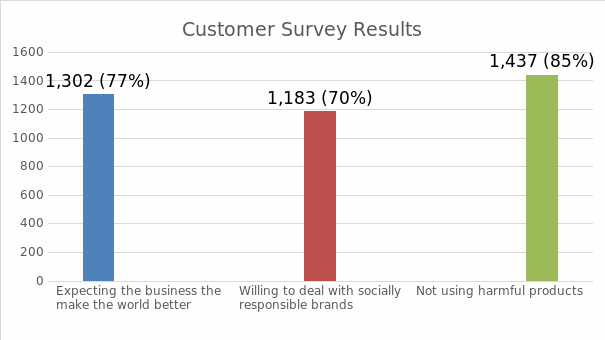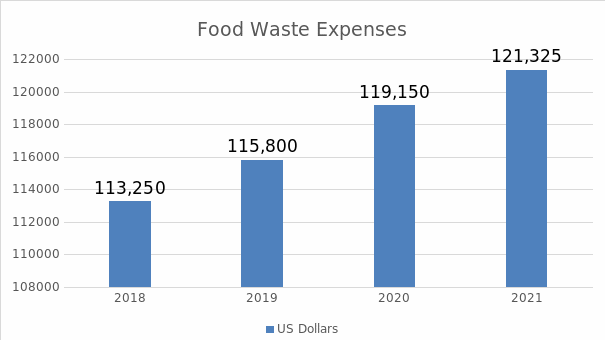Executive Summary
BestServe is a fictional self-service restaurant providing customers with versatile meals. The business currently suffers from increasing food waste that is associated with a rising economic burden and reputational disadvantages. That is why the paper aims to offer practical solutions to how the organization can address the challenges and improve its overall performance and outcomes. The report initially considers how severe the problem is for BestServe and then suggests that opening a soup kitchen and offering 10% discounts for preordered meals can be helpful. The rationale behind this statement is that these interventions help the organization reduce its expenses and demonstrate that BestServe is a socially responsible business drawing attention to social issues. In conclusion, the report shows that BestServe should rely on suggested interventions to find community partnerships that will contribute to the further development of the business.
Introduction
Food waste is a severe challenge in the present world. The rationale behind this statement is that while some people do not know what to do with food leftovers, others are forced to make efforts to find means of existence. That is why many modern businesses try to ensure that their operations are sustainable and responsible. BestServe (a fictional business) is among such companies, and it currently suffers from significant food waste. The problem results in ethical and economic disadvantages, meaning that a practical solution is required. Opening soup kitchens and offering 10% discounts for preordered food are suitable interventions that can lead to improved customer satisfaction and money savings.
Current Process
BestServe is a self-service restaurant chain providing its customers with traditional cuisine and a decent level of service. The performance analysis has demonstrated that leftovers or food waste are a significant problem for the business. Firstly, this state of affairs results in an increased workload for employees who are forced to spend more time (30-60 minutes per day) to remove these leftovers. Secondly, having much food waste implies an adverse impact on the company’s image because it cannot be considered socially responsible and ethical. Finally, the current problem is associated with an economic burden because the firm spends more money and should find ways and funds to keep, store, manage, and recycle or dispose of this waste. Consequently, this evidence demonstrates that food waste results in inefficiencies in the spheres of Human Resources, Company Image, and Financial Activities.
If one wants to determine whether the suggested problem deserves attention, it is reasonable to look at the following figures. On the one hand, a visual below demonstrates that a high proportion of Americans draw attention to whether a brand or business invests efforts in being socially responsible (see fig. 1). The survey of 1,691 American adults indicates that customers expect businesses to make the world better (70%), are more willing to deal with socially responsible brands (77%), and reject using harmful products (85%) (Aflac 7, 16). On the other hand, the second visual demonstrates the dynamic of expenses that BestServe spent in 2018-2021 to deal with food waste (see fig. 2). This evidence reveals that the current state of affairs needs improvement because food waste is a significant concern among customers and represents a rising financial burden for the restaurant chain.


Benefits of the New Process
It is possible to expect that the two suggested interventions can result in significant and specific benefits for BestServe. Firstly, offering a 10% discount for preordered food is expected to result in the fact that the restaurant chain will have a certain understanding of how much food will be requested. This fact will denote that less food waste will be left, which, in turn, will help employees save approximately 30 minutes per day. They would be able to spend this time working with clients, improving the overall service. Secondly, the given restaurant is expected to benefit from a better reputational image. Since it has been mentioned that many American customers are concerned with the social responsibility of brands, BestServe should draw attention to this area. Thus, one can expect that introducing the soup kitchen practice can help the restaurant chain create an image of a company that addresses social and ethical issues. This fact can attract more potential clients, which will result in an increased number of customers and higher revenues.
Thirdly, it is impossible to ignore the financial aspect of the suggested solution. The available evidence (see fig. 2) reveals that waste food is a significant and growing financial burden for BestServe. According to this data, it is possible to forecast that the problem will account for approximately $124,000 in 2022. Thus, one can suggest that solving the problem with food leftovers can provide the restaurant with these savings. However, it is necessary to understand that the restaurant chain should incur some expenses to implement the intervention. This information demonstrates that it is necessary to perform a closer analysis of the financial aspect to determine the costs and benefits, and the following section will cope with the task.
Money Issue
Now, it is reasonable to calculate how many funds are necessary. It is worth admitting that no expenses, other than leading a marketing campaign, are needed to offer 10% discounts. It is possible to expect that $5,000 will be sufficient to advertise the offer and ensure that many customers are aware of it. However, the situation is much different when it comes to a soup kitchen because significant expenses are needed to open it.
Since BestServe has its own premises, it is not necessary to deal with rents, but new equipment will be needed. On average, $30,000 will suffice to purchase new cutlery, dishware, and furniture. It will be reasonable to ensure that the new items will be only used in the soup kitchen. Furthermore, $2,000 will be needed to modify the interior to ensure that the customers understand the difference between the ordinary restaurant and the new facility. It is also necessary to hire two additional employees ($20,000 annual salary for each) who will serve these customers, and no specific training will be needed. One month will be sufficient to perform all these actions, and the exact timetable is presented below.
Now, one can calculate whether the suggested solution can be effective. Total costs account for $5,000+$30,000+$2,000+$20,000+$20,000=$77,000. If these interventions had been implemented in 2021, the business would have obtained $42,150 ($119,150-$77,000) in savings. As for the current state of affairs, potential benefits are approximately $47,000 ($124,000-$77,000) per year. This information demonstrates that it is rational to consider implementing the suggested intervention to improve the performance of BestServe.
Examples of Similar Business
The literature review can offer a few examples of how soup kitchens can lead to improved outcomes for businesses. Firstly, it is possible to look at Trenton Area Soup Kitchen. This facility provided people in need with accessible food, which results in the fact that the business addresses topical social issues has a positive image in the community (Duke par. 3). Secondly, City Harvest is also a suitable example because this organization offers more accessible food to New Yorkers. In particular, the business relies on soup kitchens, which allows it to save more than 130,000 kilograms of food every day (Foodtank par. 8). Consequently, this evidence reveals that the suggested intervention can lead to reputational and physical advantages for an organization.
In addition to that, there are examples demonstrating how businesses can reduce food waste by offering discounts. On the one hand, it is possible to look at Albert Heijn, a Dutch supermarket chain, that offered dynamic discounts to reduce the volume of food waste. According to NL Times, such an approach can result in an 89% decrease in leftovers (par. 7). On the other hand, Le Pain Quotidien is a New York City bakery chain that provides its customers with discounted meals to reduce food waste. The business witnessed significant improvements after implementing the intervention because it managed to save approximately 4,000 meals in 30 days (Scripps National par. 7). This information allows for suggesting that BestServe can significantly reduce the amount of food waste if it offers discounts for preordered meals.
Community Partnerships
There is no doubt that the interventions can benefit the community and create goodwill. This statement is evident because the soup kitchen provides people in need with accessible food. Simultaneously, the discounts demonstrate that the business is ready to reduce its benefits to provide customers with more affordable products. As for a soup kitchen, this socially responsible activity is often a center of various community partnerships. A suitable example occurred in 2022, when food delivery service DoorDash decided to partner with Masbia, a kosher soup kitchen, to provide families facing food insecurity with meals (Gergely par. 1). This information means that establishing a soup kitchen can help BestServe find new partners to address social issues.
Conclusion and Recommendations
The paper has demonstrated that BestServe should reconsider its attitude toward food waste to save money and attract more customers. Opening a soup kitchen and offering a 10% discount for preordered food seem appropriate interventions, and statistical evidence supports the need for a change. BestServe will need to spend $77,000 and one month to implement these strategies, but they promise to bring positive outcomes, meaning that the business should not doubt the necessity to rely on them.
Works Cited
Aflac. “2019 Aflac CSR Survey Report Results and Analysis.” Web.
Duke, India. “Trenton Area Soup Kitchen Demonstrates how to Reduce Food Waste.” NJ, 2019, Web.
Foodtank. “20 Organizations Diverting Food Waste to Provide Meals for People in Need.” 2020, Web.
Gergely, Julia. “A Kosher Soup Kitchen Partners with DoorDash to Help New Yorkers in Need.” NY Jewish Week, 2022, Web.
NL Times. “Albert Heijn to Combat Food Waste with ‘Dynamic Discounts.’” 2019, Web.
Scripps National. “New App Aims to Reduce Restaurant Food Waste, Offer Discounted Meals.” 2022, Web.